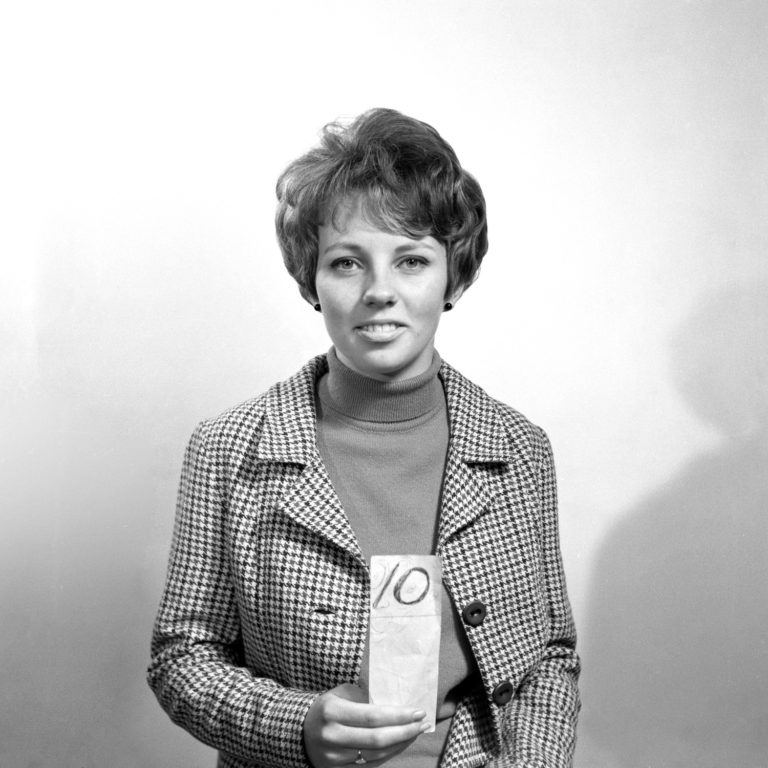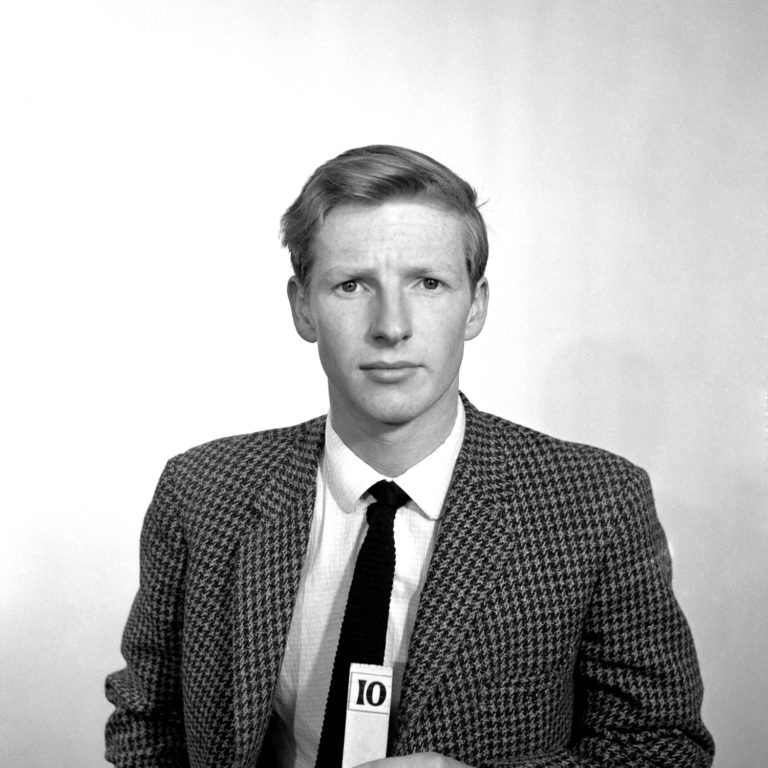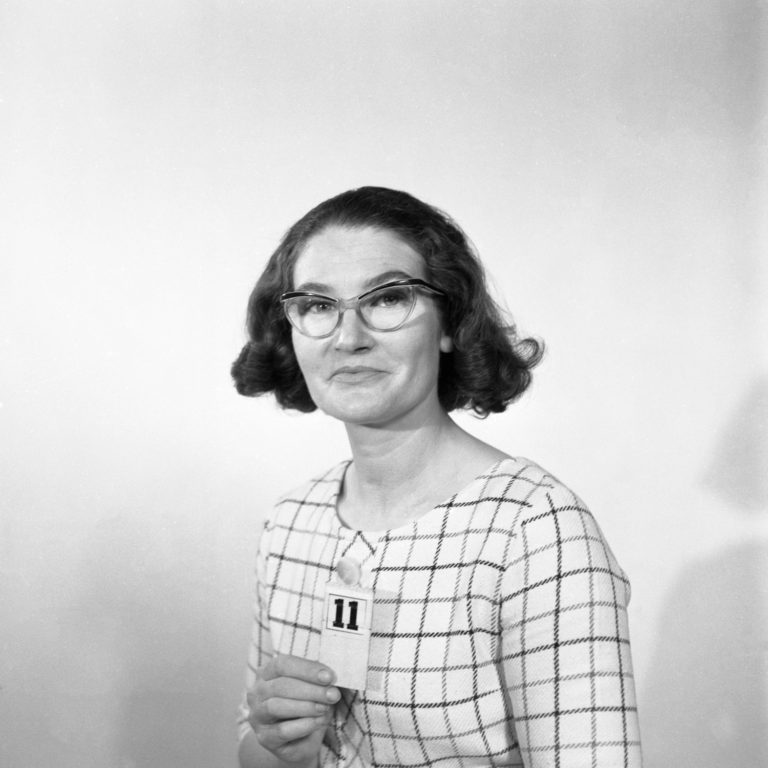Passport Photographs, July 1966 – June 1968
Reference: BRO 1944/1/5054/1, 16, 21 & BRO 1944/1/4596/4
Suggested age groups: KS2, KS3, KS4, KS5, Lifelong Learners
Subject areas: Portraiture, Photography, Travel
CONTEXT
Originally founded in 1951 as the Photo-News Service, the Photo Centre in Berwick was a staple of town life for over 65 years as a family-run press agency and photo studio.
Their premises at 17 Bridge Street had a well-equipped studio above the shop where commercial photography took place. The business also covered newsworthy events in the area and recorded family occasions and celebrations, marking milestones in the lives of several generations of townspeople.
From the beginning of the 1960s the Photo Centre catalogues show a marked increase in the number of passport photographs taken. This goes hand in hand with the popularity for foreign holidays which also grew during this time. These portraits, like those taken for passports today are governed by certain rules. The subject should be photographed against a plain background and their whole face should be shown. The number held by each sitter would not have appeared in the final print when the film was developed, but have helped with identification.
Portraiture, or portrait photography, is one of the most common types of photography. In a portrait, the photograph captures the subject, for example a person or group of people, in a way that the face, facial features and facial expressions are made prominent. This does not mean that only the face and head can be visible in a portrait, a portrait can contain the subject’s full body.
A portrait photograph may be artistic, posed or candid, and can be taken in any environment, such as in a studio, outdoors or on location, and can be taken using studio lighting or natural/available light. Portraits can also fall into sub-genres, such as traditional portraits; environmental portraiture – photographing the subject in their natural environment such as their workplace; fashion portraits; self-portraits; commercial portraits including headshots – such as passport photographs or professional portraits used by actors; conceptual and fine art portraits.
ARTISTS BANK
Herb Ritts
American fashion and portrait photographer, known for photographing celebrities, models and cultural figures during the 1980s and 1990s. His work concentrated on black and white photography and portraits, often in the style of classical Greek sculpture, which emphasized the human shape.
Example portrait images: Jack Nicholson, Los Angeles 1986; Djimon with Octopus, Hollywood 1989; Eunice Shriver, Los Angeles 1995
Irving Penn
Best known for his fashion photography, Penn’s work also included portraits, often posing subjects against simple white or grey backdrops for simplicity; ethnographic photographs from around the world; still-life works of food, bones, bottles, metal, and found objects; and photographic travel essays.
Example portrait images: Sophia Loren, New York 1959; Issey Miyake, New York 1988; Pablo Picasso at La Californie, Cannes 1957
Jane Bown
British photojournalist and portrait photographer Jane Bown is known for her straightforward, naturally posed, black and white portraits usually taken with available light.
Example portrait images: Trevor Phillips, 1999; Edith Sitwell, 1959; Princess Anne, 1980
Steve McCurry
Portrait photographer and photojournalist Steve McCurry’s body of work spans conflicts, vanishing cultures, ancient traditions, and contemporary culture alike – yet always retains the human element.
Portrait portfolio: https://www.stevemccurry.com/galleries/portraits
Helen Warner
Helen Warner’s portraits are inspired by the myths and legends of Northern Ireland. She experiments with different materials and props to create emotive images bordering between dream and reality.
Portrait portfolio: http://www.helen-warner.com/photography
Lee Jeffries
The main subjects of Lee Jeffries’ photography are homeless people. He is one of the portrait photographers who has attempted to capture at least a bit of hope and faith in their eyes.
Portrait portfolio: https://lee-jeffries.co.uk/lost-angels
ACTIVITIES
ACTIVITY 1
Background
From the beginning of the 1960s the Photo Centre catalogues show a marked increase in the number of passport photographs taken. This goes hand in hand with the popularity for foreign holidays which also grew during this time.
SEE
See: What were these photographs used for?
See: Why was there an increase in the number of passport photographs at this time?
THINK
Think: Why did foreign holidays became more popular during the 1960s?
Think: Where did people go on holiday prior to this?
Think: Who might have gone on foreign holidays or traveled internationally prior to this?
Think: How did the package holiday of the 1960s differ from the Grand Tour of the 18th century?
Think: How might the 1960s package holiday differ from foreign travel today?
DO
Do: Create a map showing where British people travelled abroad to holiday during the 1960s.
Do: Take a survey of the people around you. How many people have been on a foreign holiday? How many of these holidays were to places on your map of 1960s destinations?
Do: Discuss the impact the Second World War had on the emergence of the tourism industry.
Do: Discuss the correlation between social class and the emergence of the tourism industry.
Do: Design a 1960s airline poster.
Do: Research 1960s British holiday camps. Design a schedule of activities for one of these holiday camps.
Resources
ACTIVITY 2
Background
Portraiture, or portrait photography, is one of the most common types of photography. In a portrait, the photograph captures the subject, for example a person or group of people, in a way that the face, facial features and facial expressions are made prominent. This does not mean that only the face and head can be visible in a portrait, a portrait can contain the subject’s full body.
SEE
See: What is a portrait photograph?
See: What are the main characteristics of a portrait?
See: What type of portrait are these photographs?
THINK
Think: What type of lighting do you think was used when shooting these photographs?
Think: Where do you think the lights were placed in comparison to the subject?
Think: Do you think this is a good or bad example of studio portrait lighting? How might you light it differently if the portraits had a different use?
Think: Do you think the studio used the same setup for each passport portrait subject or do you think this changed based on the person being photographed? Why?
Think: Are these photographs similar or different to passport photos today?
Think: What do the facial expressions in these portraits tell you about the subject?
DO
Do: Create your own series of headshots in the style of these passport portraits.
Do: Create a series of portrait photographs in the style of a different photographer. You could choose a sub-genre of portraiture to explore.
Do: Experiment with how to show expression within portraits. You could think about how to express power, emotion, sensitivity and so on. What happens if you change the shooting angle or type of lighting used?
Do: Experiment with showing different personalities within portraiture. Think about how and where you position your subject, any props you might use and different facial expressions they may have.
Do: Create an Andy Warhol Pop Art style image using the four photographs. You could edit the images digitally or by hand.
Do: Create a Jenny Saville inspired self-portrait using a scanner or photocopier to distort your subject.
Do: Create your own portraiture series working in your own style with your own theme, showing either expression or personality.
Resources
https://www.moma.org/collection/works/portfolios/61240
https://www.tate.org.uk/art/art-terms/p/pop-art
https://niquellelatouche.wordpress.com/2014/10/08/saville-inspired-images-a-little-body-scan/
https://www.royalacademy.org.uk/art-artists/name/jenny-saville-ra
https://www.format.com/magazine/resources/photography/lighting-in-photography
OTHER ONLINE RESOURCES
Early Photography
Science Museum website, page about history of photography: https://www.scienceandmediamuseum.org.uk/objects-and-stories/history-photography
British Library website, page about invention of photograph (Henry Fox Talbot): https://www.bl.uk/collection-items/invention-of-photography
Bodleian website, biography of Henry Fox Talbot: https://talbot.bodleian.ox.ac.uk/talbot/biography/
Photo Centre
Portrait of a Town exhibition: https://www.photocentreberwick.co.uk/portrait-of-a-town/work-and-industry
Photo Centre workshop resources: https://www.photocentreberwick.co.uk/learning
Portraiture
Headshot London blog, What is Portraiture? – https://www.headshotlondon.co.uk/blog/what-is-a-portrait-photography/
History of Photography, Portraits – https://notquiteinfocus.com/2014/10/16/a-brief-history-of-photography-part-11-early-portrait-photography/
Tate, Portraiture – https://www.tate.org.uk/art/art-terms/p/portrait
How portrait photography evolved over time – https://www.scancafe.com/blog/the-evolution-of-portrait-photography
Foreign Holidays
BBC Magazine, Memories of 1960s holidays – http://news.bbc.co.uk/1/hi/magazine/6707679.stm
The Package Holiday Revolution – https://www.historyextra.com/period/victorian/the-package-holiday-revolution/
A social history of holidays – https://www.familyholidayassociation.org.uk/blog/how-times-have-changed-a-social-history-of-holidays/
British seaside holidays – https://www.historic-uk.com/CultureUK/Great-British-Seaside-Holiday/





